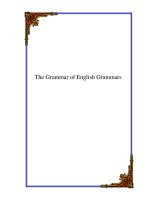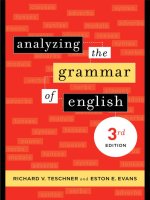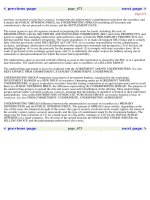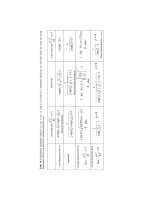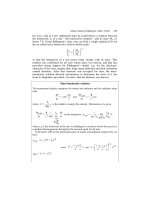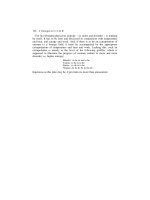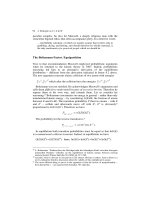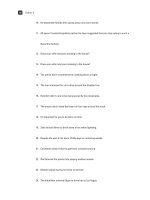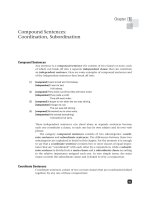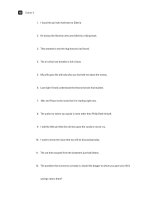Analyzing the Grammar of English Third Edition phần 10 pps
Bạn đang xem bản rút gọn của tài liệu. Xem và tải ngay bản đầy đủ của tài liệu tại đây (218.15 KB, 27 trang )
Chapter 8
206
10. He absolutely forbids their giving away any more money.
11. All seven Constantinopolitan patriarchs have suggested that you stop acting in such a
Byzantine fashion.
12. Does your wife mind you smoking in the house?
13. Does your wife mind your smoking in the house?
14. The police don’t recommend her walking alone at night.
15. The man motioned for us to drive around the disabled car.
16. Heimlich didn’t care to be maneuvered by his classmates.
17. The angry coach made the team run four laps around the track.
18. It’s important for you to be there on time.
19. Zeke forced Abner to drink some of his white lightning.
20. Despite the pain in his back, Phillip kept on removing weeds.
21. Constantin doesn’t like his partner’s constant snoring.
22. We flattered the pianist into playing another sonata.
23. Maude enjoys having her back scratched.
24. The hitchhiker ordered Edgar to drive her to Las Vegas.
183-210.Teschner.08.indd 206183-210.Teschner.08.indd 206 4/2/07 6:13:47 PM4/2/07 6:13:47 PM
207
B. Write two original sentences corresponding to each of the following descriptions.
1. that-clause
2. purpose complement
3. infinitive complement with equi-deletion
4. infinitive complement with raising to object
5. gerund complement with equi-deletion
6. gerund complement with raising to object
C. Some of these sentences exhibit one pattern of complementation but could just as well
convey the same meaning through a different pattern. If possible, rewrite each of the sen-
tences below, using any other complementation pattern that preserves the meaning of the
original. Label the pattern that appears in print as well as the pattern you have written down.
1. It’s urgent that she call her answering service.
2. Did the principal make Bart stay after school again?
3. I dared them to jump off the top of the Sears Tower.
4. The judged considered the witness to be lying.
5. We intend for them to pay us what they owe.
6. England expects every man to do his duty!
7. They said for us to take off our shoes at the door.
8. Why do you urge that she become a psychiatrist?
9. John loves dancing the foxtrot.
Summary of All Clausal Complementation Patterns
183-210.Teschner.08.indd 207183-210.Teschner.08.indd 207 4/2/07 6:13:48 PM4/2/07 6:13:48 PM
Chapter 8
208
10. She hates it that her husband bathes the dog in the kitchen.
11. I expressly forbid her leaving school before she turns fourteen.
12. What did you instruct us to do today?
13. The cheerleaders prayed for their team to win.
14. We had hoped that you would visit us this summer.
15. An understanding classmate helped Henry learn Ancient Aramaic.
16. Dirk saw the Nazis coming down the street.
17. The family prefers that Tiffany buy a new pair of topsiders.
18. Helga said she would give her right arm to be ambidextrous.
19. Did you remember that you owed me $1,000?
20. Jeff tempted Richard to order another dessert.
D. Determine whether there is any difference in meaning between each of these comple-
mentized pairs, then explain what that difference consists of.
1. a. Harvey remembered to lock the door.
b. Harvey remembered locking the door.
2. a. Mabel heard Cecilia Bartoli sing.
b. Mabel heard Cecilia Bartoli singing.
3. a. The colonel advised that the soldier be court-martialed.
b. The colonel advised the soldier to be court-martialed.
4. a. Julius neglected to study.
b. Julius neglected studying.
183-210.Teschner.08.indd 208183-210.Teschner.08.indd 208 4/2/07 6:13:48 PM4/2/07 6:13:48 PM
209
5. a. Ms. Hendrix admires the man’s singing.
b. Ms. Hendrix admires the man singing.
6. a. Would the hostess mind our bringing our own wine?
b. Would the hostess mind us bringing our own wine?
E. The following two sentences reveal a similar word order but manifest semantically differ-
ent matrix verbs and unquestionably different underlying structures. Explain the difference
between the two sentences in underlying structure and in meaning, using diagrams if you
find them helpful.
a. We persuaded him to pay for the tickets.
b. We promised him to pay for the tickets.
Summary of All Clausal Complementation Patterns
183-210.Teschner.08.indd 209183-210.Teschner.08.indd 209 4/2/07 6:13:49 PM4/2/07 6:13:49 PM
211
Appendix
Commonly Used Matrix Verbs and the Complementation Patterns They Co-occur With
This lengthy but not exhaustive appendix lists seventy-five English verbs that are
commonly used in the main clause of our subordinate clause or tenseless com-
plement sentences. The appendix gives the nine complementation patterns dis-
cussed in this chapter and indicates which matrix verbs co-occur (are employed)
with which pattern(s). For example, advise in the main clause co-occurs with
either a that-clause complement (I advise that she sell) or with an infinitive com-
plement plus raising to object (I advise her to sell).
Excluded from this appendix are all matrix plus complementation patterns
that struck us as unnatural, stilted, obsolete, obsolescent, or possibly so. (We use
the “?” symbol to mark those patterns that strike us as possibly unnatural, obso-
lete, and so forth.) By employing the complement verb phrase sing throughout,
we seek uniformity of content to the greatest extent possible, yet the equally
compelling need to achieve naturalness of expression has given rise to minor
variations in tense or length on several occasions. It should also be noted that
given the complexity of English complementation, not all native speakers will
agree on the grammaticality of all matrix plus complementation patterns pre-
sented here, and some may actually conclude that to their own ears a particular
pattern sounds unnatural, obsolete, etc.
The verbs that are commonly used in the main clauses of compound sen-
tences appear in boldface type at the start of each entry, thus: admit, advise,
ask, attempt, . . . Numbered sentences follow each matrix verb; the numbers
correspond to the numbers of the subordination patterns that the matrix verbs
can co-occur with, with the numbered sentences exemplifying each of the sub-
ordinate clause patterns with which the particular matrix verb co-occurs. (While
some matrix verbs can co-occur with just one or two subordinate clause patterns
and others with as many as six or seven, there is no matrix verb that co-occurs
with all nine patterns.) The numbers illustrating each pattern range from 1 to 9;
explained and exemplified below are each of the subordination patterns that the
matrix verbs can co-occur with:
1. The complement is a subordinate that-clause, with the clause’s verb in the
subjunctive. (Example: I prefer that she sing lullabies. In this example, the
matrix verb is prefer while the subordinate that-clause’s verb is sing. We
know that sing is in the subjunctive mode because it lacks the 3.sg.pres.
tense /z/ morpheme.)
211-218.Teschner.APP.indd 211211-218.Teschner.APP.indd 211 4/2/07 6:15:51 PM4/2/07 6:15:51 PM
Appendix
212
2. The complement is a subordinate that-clause, with the clause’s verb in the
indicative. (Example: I know that she sings lullabies. In this example, the
matrix verb is know while the subordinate that-clause’s verb is sings. We
know that sings is in the indicative mode because it ends in the characteris-
tic 3.sg.pres tense /z/ morpheme.)
3. The complement is an infinitive. Pattern 3 is characterized by equi-deletion
with retention of the infinitive marker to. (Example: I prefer to sing.)
4. The complement is an infinitive. Pattern 4 entails raising to object, and the
infinitive marker (to) is deleted in the process. (Example: I made her sing.)
5. The complement is an infinitive. Pattern 5 entails raising to object, and the
infinitive marker to is retained. (Example: I prefer her to sing lullabies.)
6. The complement is an infinitive. Pattern 6 entails raising to object, and the
infinitive marker to is complemented by the discontinuous pre-posed for.
(Example: I prefer for her to sing.)
7. The complement is a gerund. Pattern 7 is characterized by equi-deletion.
(Example: I prefer singing.)
8. The complement is a gerund. Pattern 8 entails raising to object. (Example: I
prefer him singing, not chanting.)
9. The complement is a gerund. Pattern 9 entails raising to genitive (specifi-
cally, a possessive determiner). (Example: I prefer his singing.)
Matrix verbs Subordinate clause construction types
admit 2. I admit that she sings adequately.
7. I admit singing for hours on end
advise 1. I advise that you sing on key.
5. I advised her to sing on key.
9. ?I advised her singing anywhere but in a nightclub.
allow (permit) 5. I allowed her to sing endlessly.
6. ?I allowed for her to sing endlessly.
7. I allow singing in my tavern.
9. I allowed his singing to go on and on.
allow (acknowledge) 2. I allow that she sings adequately.
ask 1. May I ask that you sing a little less loudly?
3. I only ask to sing for my supper.
5. I asked him to sing on key.
6. I asked for him to sing on key.
attempt 3. I attempted to sing, but failed.
7. I attempted singing, but failed.
authorize 5. I authorized them to sing at the concert.
9. I authorized their singing at the concert.
avoid 7. I avoid singing like the plague.
9. I avoid her singing whenever I possibly can.
be: it + be + noun or adjective of suasion or emotional commentary
be a pleasure 3. It’d be a pleasure to sing.
6. It’d be a pleasure for her to sing.
be afraid 2. I am afraid that she sings terribly.
3. I am afraid to sing a Wagner aria.
6. I am afraid for her to sing at the recital.
211-218.Teschner.APP.indd 212211-218.Teschner.APP.indd 212 4/2/07 6:15:53 PM4/2/07 6:15:53 PM
Appendix
213
Matrix verbs Subordinate clause construction types
be awful 2. It’s awful that she sings for her supper.
3. It’s awful to sing in front of such an audience.
6. It’s awful for her to sing in front of those people.
be desirable 1. It’s desirable that he sing classical music.
3. It’s desirable to sing in Carnegie Hall.
6. It’s desirable for him to sing at least twice a day.
be determined
(insistent)
1. We were determined that he sing the song again.
3. We were determined to sing.
6. We were determined for him to sing the song again.
be eager 1. They are eager that he sing like an angel.
3. They are eager to sing like angels.
6. They are eager for him to sing like an angel.
be essential 1. It’s essential that he sing classical music.
3. It’s essential to sing at the Met at least once.
6. It’s essential for her to sing Bach cantatas.
be happy 2. They are happy that she sings like Cecilia Bartoli.
3. She is happy to sing like Cecilia Bartoli.
6. They are happy for her to sing like Cecilia Bartoli.
be important 1. It’s important that she sing a song of sixpence.
3. It’s important to sing from early childhood onward.
6. It’s essential for her to sing on key for a change.
be insistent 1. You are insistent that she sing on key.
be necessary 1. It’s necessary that he sing along with Mitch.
3. It’s necessary that he sing sweet songs of love.
6. It’s necessary for him to sing as fast as he can.
be nice 2. It’s nice that she sings so loud and clear.
3. It’s nice to sing before such a great crowd tonight.
6. It’s nice for her to sing when I play the piano.
be sad 2. It was sad that he sang so poorly.
3. It was sad to sing so poorly before so many people.
6. It was sad for him to sing like a sick cow in heat.
beg 1. I begged that she sing a silly song.
3. I begged to sing a silly song.
5. I begged her to sing a silly song.
6. I begged for her to sing a silly song.
believe 2. I believe that he sings off key.
5. I believe him to sing off key.
care 2. I care that she sings enormously well.
3. She always cared enough to sing enormously well.
6. I cared for her to sing enormously well.
cause 5. We caused him to sing off key.
6. By our actions, we caused singing to happen.
9. We caused his singing to happen.
command 1. ?I command that she sing about the Easter bunny.
5. I command her to sing about the Easter bunny.
compel 5. I compelled him to sing.
convince 5. They convinced her to sing.
211-218.Teschner.APP.indd 213211-218.Teschner.APP.indd 213 4/2/07 6:15:53 PM4/2/07 6:15:53 PM
Appendix
214
Matrix verbs Subordinate clause construction types
crave 1. I crave that he sing.
3. I crave to sing at the Met.
6. I crave for him to sing so sweetly.
7. I crave singing and dancing.
9. I crave his singing.
decree (order) 1. I decree that she sing for her supper.
demand 1. We demand that he sing “O sole mio.”
3. We demand to sing “O sole mio.”
6. We demand for him to sing “O sole mio.”
deprive . . . of 8. They deprived him of singing for seven whole months.
desire 1. They desired that he sing.
3. They desired to sing.
5. They desired him to sing.
7. They desired singing at their wedding.
9. They desired his singing at their wedding.
determine (decree) 1. I determined that she sing in public.
dread 6. I dreaded for him to sing.
7. I dread singing.
8. I dreaded him singing the national anthem.
9. I dread his singing most of all.
drive (impel, force) 5. They drove her to sing for hours on end.
encourage 5. We encouraged him to sing at the corner bar.
7. We encouraged singing at the corner bar.
9. We encouraged his singing at the corner bar.
enjoy 6. They enjoyed for him to sing at top volume.
7. They enjoyed singing at top volume.
8. They enjoyed him singing at top volume.
9. They enjoyed his singing at top volume.
entice 5. I enticed her to sing.
expect (wish; cf.
assume)
2. We expect that she sings beautifully.
3. We expect to sing at the country club next year.
5. We expect her to sing at the country club next year.
6. We expect for her to sing at the country club.
7. We expect singing at the country club.
fail 3. We always fail to sing on key.
flatter . . . into 8. I flattered him into singing “O sole mio.”
forbid 1. I forbid that he sing in Ruthenian.
5. I forbid him to sing in Ruthenian.
7. I forbid singing in Ruthenian.
8. I forbid him singing in Ruthenian.
9. I forbid his singing in Ruthenian.
force 5. I forced him to sing in Hungarian.
9. ?I forced his singing in Hungarian.
have (obligate) 4. We had her sing all night long.
8. We had her singing all night long.
hear (to be given to
understand)
2. They heard that he sings old Sinatra songs.
211-218.Teschner.APP.indd 214211-218.Teschner.APP.indd 214 4/2/07 6:15:54 PM4/2/07 6:15:54 PM
Appendix
215
Matrix verbs Subordinate clause construction types
hear (to perceive
aurally)
4. They heard him sing old Sinatra songs.
7. They heard singing from inside the corner bar.
8. They heard him singing inside the corner bar.
9. They heard his singing inside the corner bar.
help 3. Every week they help to sing in the choir.
4. They helped her sing in the choir.
5. They helped her to sing in the choir.
hint 1. I hinted that she sing at least one song.
2. I hinted that she sings quite nicely.
6. I hinted for her to sing.
imply 2. I implied that she sings quite nicely.
induce 5. They induced him to sing just one more song.
influence 5. We influenced him to sing in the key of B flat.
9. We influenced his singing in the key of B flat.
insist (command) 1. I insist that she sing at the top of her lungs.
6. I insist for her to sing at the top of her lungs.
insist on 7. They insisted on singing all night.
8. They insisted on him singing all night.
9. They insisted on his singing all night.
know 2. I know that she sings on Sundays.
5. I know her to sing on Sundays.
6. I have known for her to sing on Sundays.
7. I know singing.
9. I know his singing.
lead 5. We always lead her to sing.
let 4. We let her sing whenever she wants to.
like 3. I like to sing.
5. I like him to sing.
6. I like for him to sing.
7. I like singing.
8. I used to like him singing all day long.
9. I used to like his singing all day long.
long 3. I long to sing falsetto.
6. I long for her to sing basso profundo.
love 3. We love to sing old work songs.
5. We expect her to sing old work songs.
6. We love for her to sing.
7. We love singing.
8. We love him singing.
9. We love his singing.
make (obligate) 4. I made her sing.
mention 2. I mentioned that he sings.
7. I mentioned singing.
9. I mentioned his singing.
move (propose a
course of action)
1. I move that she sing an aria.
6. I moved for her to sing an aria.
need 3. I need to sing scales to keep in practice.
211-218.Teschner.APP.indd 215211-218.Teschner.APP.indd 215 4/2/07 6:15:55 PM4/2/07 6:15:55 PM
Appendix
216
Matrix verbs Subordinate clause construction types
5. I need him to sing scales to keep in practice.
6. I need for him to sing scales to keep in practice.
7. I need singing in my life.
8. I need him singing in my life.
9. I need his singing in my life.
obligate 5. I obligated him to sing for seven hours.
9. ?I obligated his singing for seven hours.
order 1. I order that she sing.
5. I ordered her to sing.
6. I ordered for her to sing.
7. I ordered singing, not violin playing.
9. ?I ordered her singing, not her playing the violin.
permit 5. They permitted him to sing.
7. They permitted singing.
8. ?They permitted him singing.
9. They permitted his singing.
persuade 5. We persuaded her to sing one final song.
pray 1. We pray that she sing on key.
3. We prayed to sing at her wedding.
6. We prayed for her to sing on key.
prefer 1. I prefer that she sing opera.
3. I prefer to sing, not chant.
5. I prefer her to sing opera.
6. I prefer for her to sing opera.
7. I prefer singing.
8. I prefer him singing Brahms, not Schubert.
9. I prefer his singing ragtime, not jazz.
prevent ( . . . from) 7. I prevent singing whenever I can.
8. I prevented him from singing last night.
9. I prevented his singing last night.
propose 1. I propose that she sing another round.
3. I propose to sing another round.
5. I propose her to sing another round.
6. I propose for her to sing another round.
7. I propose singing one more round.
8. I propose him singing one more round.
9. I propose his singing one more round.
recommend 1. They recommend that we sing.
6. They recommend for us to sing.
7. They recommend singing.
9. They recommend our singing.
remind 2. They reminded [us] that she sings beautifully.
5. They reminded her to sing.
report 2. I can report that he sings wonderfully.
7. The cops reported singing at 3 p.m. in a dark alley.
8. The cops reported him singing too loud at that hour.
9. The cops reported his singing too loud at that hour.
211-218.Teschner.APP.indd 216211-218.Teschner.APP.indd 216 4/2/07 6:15:56 PM4/2/07 6:15:56 PM
Appendix
217
Matrix verbs Subordinate clause construction types
request 1. I request that you sing along.
3. I request to sing.
5. I requested her to sing, but she wouldn’t.
6. I requested for her to sing, but she wouldn’t.
7. I requested singing.
9. I requested her singing, but she refused.
require 1. They required that we sing.
3. ?They required to sing.
5. They required us to sing.
6. ?They required for us to sing.
7. They required singing.
8. ?They required us singing.
9. They required our singing.
rule 1. The court ruled that he sing.
6. The court ruled for him to sing.
signal 2. I signaled to the awaiting masses that I sing well.
5. I signaled her to sing.
6. I signaled for her to sing.
stipulate 1. They stipulated that we sing to work off our penalty.
6. ?They stipulated for us to sing.
7. They stipulated singing, not yodeling.
9. They stipulated our singing, not our yodeling.
suggest (mildly com-
mand; cf. venture an
opinion)
1. I suggested that she sing.
6. I suggest for her to sing.
7. I suggest singing.
9. I suggest her singing.
tempt 5. Jeffrey tempted him to order another dessert.
8. Jeffrey tempted him into ordering another dessert.
trick . . . into 8. Jeffrey tricked him into ordering another dessert.
urge 1. We urge that she sing in tune.
5. We urge her to sing in tune.
want 3. They want to sing.
5. They want him to sing.
6. They want for him to sing.
8. They want him singing.
9. They want his singing.
warn (urge
threateningly)
5. They warned her not to sing.
6. They warned for her not to sing.
wish 3. I wish to sing right now.
5. I wish him to sing right now.
6. I wished for him to sing immediately.
211-218.Teschner.APP.indd 217211-218.Teschner.APP.indd 217 4/2/07 6:15:56 PM4/2/07 6:15:56 PM
219
Glossary of Terms
ablauting in a conjugated verb form, any vowel change that alternates
active voice a verb construction appearing in a clause whose actor is also the grammatical
subject
actor the entity (usually human) that performs an action verb’s action
adjective a word that describes, modifies, limits, distinguishes, or otherwise characterizes
the noun it forms part of a noun phrase with or—if predicate—refers back to
adverb a word that describes, modifies, limits, distinguishes, or otherwise tells us something
about a verb
agent phrase in a passive voice construction, the prepositional phrase that begins with by
and contains the clause’s actor
agentless passive a passive voice construction that lacks the agent phrase
allomorph the actual unit of meaning itself (see morpheme)
allophones articulatorally/acoustically related phones that do not change the meaning of a
word when they are substituted for one another
article part of the determiner category, an article is either definite (the, marking old informa-
tion) or indefinite (a[n], some, marking new information)
attributive adjective an adjective that appears in the same noun phrase as the noun it
modifies
auxiliary inversion the process by which an auxiliary gets placed before its subject
auxiliary verb the less semantically rich part of the verb phrase (see lexical verb); the verb
phrase word(s) limited in function to marking person, number, tense, voice, etc.
bound morpheme a morpheme that must be attached to a free morpheme to convey meaning
case the different functions that a form can perform, along with the formal differences as
these are determined by function; English cases are subject, object (whether direct or
indirect), and genitive/possessive
clausal adjective complement a subordinate clause that corefers to an immediately ante-
cedent adjective in a compound subordinate sentence, explaining that adjective or defin-
ing it, describing it, etc.
clausal adverb complement a subordinate clause that answers an adverbial question such
as When? or Where? and thereby functions as an adverbial element in the compound
subordinate sentence
clausal complementation process and product whereby an entire clause complements
another clause by adding information to it
219-228.Teschner.GL.indd 219219-228.Teschner.GL.indd 219 4/2/07 6:16:33 PM4/2/07 6:16:33 PM
Glossary of Terms
220
clausal noun complement a subordinate clause that corefers to an immediately antecedent
noun in a compound subordinate sentence
clausal object complement a subordinate clause that functions as the object of the main
clause’s verb in the compound subordinate sentence
clausal predicate nominative complement a subordinate clause that follows a form of the
verb BE in a compound subordinate sentence and functions as a coreferential to a noun
appearing in the matrix clause
clausal subject complement a clause that functions as the subject in a compound subordi-
nate sentence
clause a sense-making utterance containing a subject and a predicate
clauseless sentence a sentence whose contents do not add up to a clause
cleft fronting fronting that entails word order changes elsewhere in the clause or the
sentence
clefting (see it-clefting, wh-clefting, cleft fronting)
closed vowel in English, /i i υ u/, vowels articulated with the tongue in high position and
thus close to the roof of the mouth (see nonclosed vowel)
coarticulatory feature one articulatory operation (phonetic production) that is taking place
at the same time as another
common noun any noun that is not a proper noun
comparative (form/function of an adjective) the form that is used to indicate something
is more . . . than something else
complement something—a tenseless verb form, a noun phrase, a prepositional verb phrase,
etc.—that completes a conjugated verb form’s intentions by adding information to the
predicate in which it is found
complementizer a conjunction or relative pronoun that begins a subordinate clause; com-
mon complementizers are that, as, for . . . to, than, and if
compound sentence a sentence consisting of at least two clauses, each of which can be
separated off into its own independent clause and independent sentence
compound tense any tense in which the verb phrase consists of more than one word—at
least one auxiliary verb plus the LV
conditionality bi-clausal construction in which the if-clause (protasis) expresses the condi-
tion that must exist before something else can happen, while the result clause (apodosis)
expresses the something else
conjugated verb form any shape that a verb—derived from its respective verbal infinitive—
assumes when it is marked for tense, person, or number
conjunction a word whose grammatical function is to link or join one clause to another
contraction process and product of combining two words into a single word while deleting
part of one of them; apostrophes are always used
coordinate sentence one containing two or more clauses of equal importance, neither one
of which controls or governs the other; the clauses of a coordinate sentence are linked by
a coordinating conjunction
coordinating conjunction a conjunction that links one coordinate clause to another; the
most frequently used are and, (either)/or, (neither)/nor, but, yet, and for
coreferential a relationship of identity or sameness between two grammatical entities such
that each manifests the morphological and semantic characteristics of the other; co-ref-
erentiality typically involves the relationship between two nouns (George is a translator),
a noun and an adjective (the house is green, the green house), a noun and a pronoun (The
house? I can’t find it), etc.
count noun any noun that allows pluralization and can be modified by plural numbers or
by quantifiers such as many
219-228.Teschner.GL.indd 220219-228.Teschner.GL.indd 220 4/2/07 6:16:35 PM4/2/07 6:16:35 PM
Glossary of Terms
221
declarative question yes/no question that lacks the syntactical attributes such as auxiliary
inversion, do-insertion, etc., that would make it a canonical interrogative; instead, intona-
tion alone makes it function as a question
deep structure representation of the elements that underlie a given construction’s surface
structure
demonstrative either as a determiner or as a pronoun, a demonstrative points out how close
to the speaker or hearer an entity is
derivational bound morpheme a morpheme that typically changes the part of speech of
the free morpheme to which it is added
descriptive grammar an approach to linguistic analysis that presents the facts about a lan-
guage as it is actually spoken
determiner an article (definite or indefinite), a demonstrative, or a possessive that appears
in front of a noun and “determines” something about it such as the noun’s informational
newness, its proximity to the speaker, to whom the noun belongs, etc.
devoicing a process by which a voiced consonant becomes voiceless
diphthong a single-syllable combination of two closed vowels or of one closed and one
nonclosed vowel
direct object the first recipient of the action of a transitive verb
discontinuous complementizer for . . . to when used as a subordinate clause initial element,
called “discontinuous” because it is interrupted by the raised-to-object subject of the clause
do-insertion a process by means of which the nonmodal auxiliary verb do is added to an
affirmative statement to make it negative, interrogative, or (at times) emphatic
dummy subject it a separated off it that initiates a type of construction known as extraposi-
tional coreferentiality
dummy verb one whose presence in the sentence is not required for semantic reasons
durative verb one whose action—typically repeated to the point of habituality—is even less
closely tied to the present moment than a stative’s
echo question recapitulatory question that repeats, directly or by paraphrase, all or part of
what someone else has just said, either to confirm it or to express surprise or disbelief
ellipsis (pl. ellipses) the omission from a construction of a word or of words that could
complete it; the deletion of an (often redundant) element that is syntactically equivalent
to something else in the construction
elliptical response an answer to a yes/no question in which only part of that question is
repeated in the response
equative (form/function of an adjective) the “base” or dictionary entry form, used
in as . . . as constructions stating that A and B are equal with respect to a trait or
characteristic
equi-deletion process and product whereby the second of two coreferential subjects is
deleted from its infinitive complement or gerund complement
existential a word or construction whose purpose is to make it clear that a given entity is
real, can be found, is locatable, etc.
extrapositional coreferentiality a construction that highlights a clausal subject (and less
frequently a clausal object) by adding a dummy subject it to the front of the sentence and
then placing the subject clause at the end of the compound subordinate sentence
form the physical shape of a word itself—the phonemes and morphemes that it contains
and how they contrast with other words; the morphemes within a word and how they are
arranged to create meaning
free morpheme a morpheme that can stand alone and convey meaning independently
219-228.Teschner.GL.indd 221219-228.Teschner.GL.indd 221 4/2/07 6:16:36 PM4/2/07 6:16:36 PM
Glossary of Terms
222
fronting to put at the front or beginning of a sentence whichever word or phrase one seeks
to emphasize
function the meaning that different forms convey when used in different contexts
gapping a phenomenon whereby a deletable element is omitted from the surface structure
of a sentence
gender a concept with morphological consequences that admits to two determining factors:
(1) the sexual characteristics of natural gender (which in the English pronoun system’s
third person singular forms will determine he, she, or it; him, her, or it; his, hers, or its,
etc.), or (2) the nonsexual-characteristics-based specificities of arbitrary gender, which in
modern English do not apply
genitive/possessive (case) the noun or pronoun designated as the possessor of something;
all genitive case nouns carry morpheme /z/ as ’(e)s/(e)s’
gerund complement a construction whereby a gerund serves as the complement of a conju-
gated LV
GET passive passive voice constructions that employ GET instead of BE as their auxiliary
verb
grammatical subject the noun or pronoun that determines the person and the number of
the predicate’s conjugated verb form
grammatical (utterance) anything a language’s native speakers say that other native speak-
ers are able to understand
grapheme letter of an alphabet
graphotactics the relationship between the sound system (phonology) and the spelling
system (orthography) of a language
hypothesis a proposition assumed as a premise; a contingency or conjecture
hypothetical something that is merely a possibility—what we say might just come true
imperative a verb’s direct command form, used in communicating an order
impersonal pronoun the word one when used to mean any person in general without specify-
ing which
indefinite pronoun a pronoun whose noun antecedent is either nonexistent (in which case
it is an antecedentless indefinite pronoun—the some or any series) or existent (in which
case it is an antecedent-bearing pronoun)
indicative (mode) unmarked or majoritarian verbal modality, morphologically identifiable
in modern English by the presence of morpheme /z/ in the 3.sg. present tense conjugated
verb form
indirect object the second recipient of the action of a transitive verb
infinitive the tenseless form of a verb that is preceded by a to infinitive complement; a con-
struction whereby an infinitive serves as the complement of a conjugated verb form
inflectional bound morpheme a morpheme that does not change the part of speech of the
free morpheme to which it is added
intensifier a type of adverb that modifies (etc.) an adjective or another adverb, attributing
to it either a higher or lower quality
interrogative pronoun any wh-word (including how) used with interrogative force at the
start of a mono- or bi-clausal question
intraclausal movement (also called
intrasentential movement) movement (of words,
phrases, or clauses) within a sentence along the lines of AB → BA
intransitive (verb) a verb that cannot take a direct object as a complement
219-228.Teschner.GL.indd 222219-228.Teschner.GL.indd 222 4/2/07 6:16:37 PM4/2/07 6:16:37 PM
Glossary of Terms
223
invariant tag (question) a tag whose form is not dependent on whether its antecedent non-
interrogative statement is positive or negative
IPA the International Phonetic Alphabet, a consistent and universally accepted system for
transcribing (writing out) the sounds of all the world’s languages
irregular verb a three-, four-, five-, or even eight-form verb whose LV undergoes vowel and/
or consonant changes when conjugated
it-clefting a type of fronting for emphasis whereby the sentence-initial it is coreferential to
the emphasized item that follows BE in the clause
lax vowel a vowel articulated with lesser muscular tension and not capable of becoming a
diphthong
length as applied to a sound segment, the amount of time spent articulating it
lexical verb (LV) the “dictionary entry bearing” or more semantically rich part of the verb
phrase (as opposed to the auxiliary verb)
LV (see lexical verb)
main clause a clause—typically the first in a compound sentence—that governs or controls
a subordinate clause
mass noun any noun that does not allow pluralization and is modified by quantity words
such as much or by measurers like a cup of, a piece of
mass-to-count shift process and product whereby a noun that normally functions as a mass
noun comes to function as a count noun
matrix verb the verb of the main clause in a compound subordinate sentence; the verb of
the main clause in a sentence that contains a tenseless complement
modal auxiliaries can, could, may, might, must, shall, should, will, would, that is, tense-limited
verbs used to express probability, possibility, ability, supposition, inevitability, obligation,
and so forth
morpheme an abstract representation of a minimal unit of meaning
morphology analysis of the form and the function of the morphemes of a given language
morphosyntactically viewed, analyzed, and categorized from the standpoint of both mor-
phology and syntax
negation making an affirmative statement negative by adding not
new information something you have just become familiar with, something not previously
identified
nonclosed vowel in English, /e ε æ ɑ ɔ o ə/, vowels articulated with the tongue further
away from the roof of the mouth (see closed vowel)
nonmodal auxiliaries be, do, and have—verbs used in compound tenses to mark person,
number, tense, voice, etc.
nonrestrictive (relative) clause a relative clause that does not restrict or limit its anteced-
ent; nonrestrictive clauses are always set off from the rest of the compound sentence by
commas
noun in terms of form, a noun is a word that can take morpheme /z/ (whether to pluralize
or to express genitive possession); in terms of function, a noun can serve in the subject,
the genitive, or the object case; nouns are also commonly known as denoting persons,
places, concepts, or things
noun phrase a combination of words the heart of which will always be a noun (accompa-
nied or not by a determiner and/or an adjective) or a pronoun
number singular (one only) or plural (more than one)
219-228.Teschner.GL.indd 223219-228.Teschner.GL.indd 223 4/2/07 6:16:38 PM4/2/07 6:16:38 PM
Glossary of Terms
224
object (case) the noun or pronoun that receives the action of a transitive verb
object of a preposition a noun or pronoun that is preceded by the preposition controlling
or governing it
old information something you already know about, something already identified
orthographic fit the degree to which the product of the graphotactics of a language is
transparent
orthography the spelling system of a language
palate roof of the mouth (oral cavity)
paraphrase a restatement of a text or passage giving its meaning in another form; the act or
process of restating or rewording
part of speech the grammatical category/ies that words belong to (such as noun, adjective,
verb, adverb . . . )
particle verb a “two-word” verb whose first word is an LV and whose second word is a par-
ticle, that is, a word that among other things can go either after or before a noun object
partitive construction one wherein the preposition of relates the entity possessed (X) to the
possessor (Y)
partitive-genitive construction one involving both morpheme /z/ in its genitive function
and preposition of in its partitive function
passive voice a verb construction appearing in a clause whose object—direct or indirect—is
the grammatical subject
past participle the form of the lexical verb that is used in perfect tense constructions; mor-
pheme /d/ marks regular past participles, while irregulars’ past participles often end in -(e)n
peak stress(ing) the most salient degree of vocal emphasis—stress even higher/lower in
pitch, louder in volume, and longer in length than ordinary strong stress—used to
emphasize or contrast a word in a phrase, a clause, or a sentence
perfect orthographic fit a graphotactic relationship according to which each individual
phoneme is spelled with one and only one grapheme and each individual grapheme rep-
resents just one phoneme
performance errors slips of the tongue caused by such inadvertent factors as haste, tension,
fatigue, inattention, inebriation, etc.
performative verb a verb that when spoken will cause the action it designates to become a
reality
perimodal a peri[phrastic] modal verb whose form-and-function flexibility often resembles
an LV’s; perimodals’ first words are either auxiliaries (be, have), modals (may, might,
would), or marginal modals (ought to)
periphrastic a multiword expression of something, typically a verb tense
person the relationship between speaker, hearer, and entity spoken about
personal pronoun a pronoun whose coreferent is [+ human]; any pronoun that though
[− human] functions morphosyntactically the way that a [+ human] pronoun does
phone any sound that the human voice makes; an actual sound itself
phoneme an abstract unit of sound that serves to distinguish meaning
phonology the sound system of a language, how phones are viewed as constituting allo-
phones of phonemes
pitch the tone (relative highness/lowness) of a sound, due to the frequency of vibration (the
number of cycles per second, how many times the object vibrates per unit of time)
possession a condition whereby X ([+/− human]) belongs to Y (usually [+ human])
predicate a clause minus its subject (i.e., whatever is “left over” from a clause once the
subject is demarcated); a predicate always contains a conjugated verb form that is part of
a verb phrase
219-228.Teschner.GL.indd 224219-228.Teschner.GL.indd 224 4/2/07 6:16:39 PM4/2/07 6:16:39 PM
Glossary of Terms
225
predicate adjective an adjective in a clause’s predicate that modifies a noun found in the
subject part of the clause
predicate noun any noun appearing in a clause’s predicate that is coreferential to the noun
that appears in the clause’s subject
prenominal appearing before a noun
preposition a word that expresses relationships between nouns, including relationships of
space, time, and degree
prepositional verb a “two-word” verb whose first word is an LV and whose second word is a
preposition
prescriptivism (prescriptive, prescriptivist) a norms-and-standards approach to the study
and analysis of language; prescriptivism’s goal is to change the way that people speak
present participle/gerund the -ing form of a verb
pro-word a pronoun-like word referring back to antecedent entities that are not nouns or
noun phrases
pronoun a word that corefers to (and/or substitutes for) a noun or a noun phrase antecedent;
a word that even while lacking such an antecedent behaves like other words that have one
proper noun a “name” of someone ([+ human]) or something ([− human]); proper nouns
always begin with a capital letter
purpose complement an infinitive that answers the question Why? and thus functions like
an adverb
quantifier a quasi-adjectival word that states the amount or quantity of whatever the noun
it corefers to denotes
raising to object process and product whereby the subject of a subordinate clause changes
into the object of a main clause (and the subordinate clause itself converts into a tenseless
infinitive or gerund complement)
raising to possessive/genitive process and product whereby the subject of a subordinate
clause changes to the possessive determiner (or to the genitive-case-marked noun) of the
tenseless gerund complement
reciprocal construction one in which A does to B what B does to A
reflexive pronoun a pronoun that is coreferential to its clause’s subject
register a socially appropriate level of language use that determines a wide variety of choices
ranging from the phonetic to the morphological, the syntactic, and the lexical; registers
range from high register through middle register and on down to low register
regular verb a four-form verb whose LV undergoes no vowel or consonant changes whatso-
ever when conjugated
relative clause a clause begun by a relative pronoun
relative pronoun a pronoun whose coreferential noun antecedent typically precedes it
relativization the transformation that changes a noun into a relative pronoun
restrictive (relative) clause a relative clause that restricts or limits its noun antecedent to
only one set of that antecedent, implicitly contrasting it to all the other members of the
antecedent’s category
schwa the mid-central to lax-front closed vowel that the other vowels can reduce to when
in unstressed position
selection question combination of two or more yes/no questions into one
semantically from the standpoint of (and as related to) the meaning of a word
sentence any sense-making piece of writing that begins with a capital letter and ends with a
period, with three dots, with a question mark or an exclamation point
219-228.Teschner.GL.indd 225219-228.Teschner.GL.indd 225 4/2/07 6:16:40 PM4/2/07 6:16:40 PM
Glossary of Terms
226
sibilant (consonants) a series of consonant sounds—in English /s z ʃ tʃ d/—characterized
by hissing- or whistling-like articulatory features
simple tense any tense in which the verb phrase consists of only one word—the conjugated
form of the lexical verb
solo fronting simply moving a word or phrase to the front of a sentence without making
any other changes in the sentence’s syntax or in the nature of its constituent elements
standard spoken English English as spoken by the most prestigious speakers of the speech
community
standard written English English as written by the most prestigious writers of the speech
community
stative verb a verb that denotes states of being or states of possessing (as opposed to actions)
stigmatized a way of speaking/writing that is looked down on and not generally accepted
by those whose use of a language is widely viewed as normative throughout a given
speech community
stress vocal emphasis involving increase and variation in pitch, volume, and/or length
subject the part of a clause that contains a noun phrase that performs an action verb’s
action, or that constitutes the theme, the focus, or the topic of a nonaction verb that
deals with a state or an equivalency; a subject also determines a conjugated verb form’s
person and number
subject case (see subject)
subjunctive (mode) marked or minoritarian verbal modality, morphologically identifiable
in modern English by the absence of /z/ where it would otherwise be expected (in the
3.sg.present tense conjugated verb form)
subordinate clause a clause—typically appearing second in a sentence—that is governed or
controlled by a matrix clause; it is the clause that cannot appear alone as written; these
clauses begin with complementizers (subordinating conjunctions) such as after, although,
as, because, before, even if, if, since
subordinate sentence a sentence containing two separable clauses, one of which is called
the main clause because it controls/governs the other one (which is called the subordi-
nate clause)
subordinating conjunction conjunctions (e.g., after, although, as, because, before, even if, if,
since, so, that, unless, when, while) that begin a subordinate clause
superlative (form/function of an adjective) the form that is used to indicate that within a
given category something manifests the highest or lowest quality on a scale
surface structure a construction’s final spoken or written product
SVO Rule a descriptive word order statement to the effect that in English, subjects usually
come first, verbs second, and objects (or complements) third
syntax the order or placement in which the words of a given language appear
synthetic a one-word expression of something, typically a verb tense
tag question the sole interrogative element in an otherwise noninterrogative sentence; a
tag question takes four different forms that respond to the noninterrogative sentence’s
assumptions and the expectations of the tag itself
tense (see verb tense)
tense vowel a vowel articulated with greater muscular tension and capable of becoming a
diphthong
tenseless lacking any tense of its own; the tenseless forms are the infinitive, the gerund/
present participle, and the past participle
tenseless verb form forms not marked for tense, including the infinitive, the gerund/pres-
ent participle, and the past participle
219-228.Teschner.GL.indd 226219-228.Teschner.GL.indd 226 4/2/07 6:16:41 PM4/2/07 6:16:41 PM
Glossary of Terms
227
that-clause complement a construction whereby a clause beginning with the subordinating
conjunction that serves as the complement of a conjugated lexical verb
time a function-centered topic that among other things refers to gradations on a chrono-
logical scale
timeless truth something that will never change unless the world ends
transitive (verb) a verb that takes or is able to take a direct object as a complement
utterance any sound that a human mouth emits; an utterance is either sense-making or
non-sense-making
verb an “action” word (expressing acts or activities), a “state” word (expressing the state or
condition a subject finds itself in), or an “equation/essence” word (indicating that subject
X is identified with predicate nominative/adjective Y)
verb phrase the heart of a predicate; always contains a conjugated verb form and may be
complemented variously by an infinitive or some other tenseless verb form, by a noun
phrase, by a predicate adjective, an adverb, or a prepositional phrase
verb tense a form-centered topic that focuses on verb forms’ shapes and the form-based
categories they belong to; tense reflects and projects such notions as chronological time,
action, duration, state, equation, etc.; English has sixteen active voice verb tenses ranging
from future through past perfect progressive
voiced sound a sound whose coarticulatory feature is the vibration of the vocal cords,
which are located in the larynx behind the Adam’s apple
voiceless sound a sound that lacks the coarticulatory feature of vocal cord vibration
voicing a process by which a voiceless consonant becomes voiced
volume loudness of a sound, due to the forcefulness (energy) of vibration; synonymous with
amplitude
vowel trapezoid the spatial representation of where the vowels of English are mapped in
the human mouth
wh-clefting a type of fronting for emphasis whereby the coreferential wh-word (relative
pronoun/pro-word) appears at the very beginning of the sentence while the coreferential
emphasized item appears at its end
wh/co question any interrogative statement beginning with a wh-word (who/what/where/
when/which/why/whose/how) and not answerable by either yes or no
wh-fronting process and product of moving the wh-word to the front of its interrogative
sentence
yes/no question any question that can be (and usually is) answered either yes or no; specifi-
cally, any query lacking a question-initial wh-word
/z/ morpheme /z/’s forms (allomorphs) are [əz], [z], and [s], and its functions include mark-
ing present tense verb form as third person singular and a noun as plural or genitive
219-228.Teschner.GL.indd 227219-228.Teschner.GL.indd 227 4/2/07 6:16:42 PM4/2/07 6:16:42 PM
229
Index
ablauting, 32–35
action (verb), 2, 7–8, 16–17, 38-39, 41, 46–47,
49–50, 54, 69, 83, 85, 95–96, 108, 114–15,
129, 132–33, 215, 219, 221–27
active voice. See transitive
active-to-passive transformation, 95–96
actor, 95, 100–101, 103, 219
adjective, 2–5, 10–11, 25, 107, 114–15, 121,
139–40, 143–45, 147–48, 151–52, 165, 171–72,
190, 193, 195, 212, 219–27
adverb, 3–5, 12, 56, 90–91, 95, 100, 108, 114, 133,
140, 148, 151–53, 170, 171–73, 175–76, 190,
195, 203, 219, 222, 224–25, 227
adverb complementation, 190, 195
affirmative (statement), 55, 57, 65, 221, 223
affricate (consonant), 29
agent (function, phrase), 96–97, 103–4, 116, 219
agentless, 103–4, 219
allomorph, 24–26, 28, 114, 219, 227
antecedent, 13, 58, 65, 128–29, 132–33, 137–38,
140, 142, 155–56, 158–59, 165, 168–69,
175–76, 179, 219–20, 222–25
arbitrary gender, 113, 118, 222
article, 14, 114, 121–22, 124, 126, 131, 202, 219,
221
assumption (in tag question), 64–66, 226
attributive (adjective), 10, 143–44, 147, 219
auxiliary inversion, 58, 63, 219
auxiliary verb, 7–8, 38, 39–41, 54, 55–57, 64, 69,
81, 96, 104, 131, 219–23
base form, 25, 31, 32, 35, 40, 46
basic structure, 55–77, 188
be as main verb, 38–39
bound morpheme, 25, 148, 219, 221–22
case, 16–18, 25, 113–16, 129, 131, 165, 219, 222,
224, 226
chevron, 22
clause, xiii, 1–3, 7, 16, 31, 47–49, 55–57, 73–74,
85, 92, 101, 106–9, 121, 131–33, 139–40,
143–44, 151, 155, 157–59, 165–66, 168,
170, 171–72, 175, 183–86, 188–93, 195–205,
211–13, 219–27
cleft(ing), 178–80, 192, 220
closed vowel, 20–21, 220–21, 223, 225
common noun, 121, 123, 220
comparative (adjective), 10, 122, 148–53, 188, 220
complement, 2, 3, 8, 15, 31, 47, 80, 82, 96, 100,
139, 190–91, 192–93, 195–205, 211–12,
219–23, 225–27
compound sentence, 157, 183–85, 188, 198–99,
211, 219–20, 221–23
compound tense, 38, 39–42, 54, 80, 82, 97, 223
conditional (tense), 31, 40–42, 49–50, 54, 73–74,
96, 106
conditional perfect (tense), 42–43, 73
conditional perfect progressive (tense), 42–43, 73
conditionality, 41–42, 49, 54, 79, 106–9, 220
confirmative (expectation), 65, 66
conjecture, 107, 222
conjugate(d), 2–3, 8, 17, 31, 38–39, 41, 71, 79, 95,
129, 219–20, 222–427
conjugating, conjugation. See conjugate(d)
contrary-to-fact, 48–49, 109
coordinate (sentence/clause), 63, 183–86, 188–89,
220–21
coreferential, 128–29, 131–32, 137–38, 158,
165–66, 172, 174–75, 179, 192–93, 195,
220–21, 225, 227
copula (verb), 143, 192
count noun, 121, 123–25, 150, 220, 223
/d/ morpheme, 28–29, 31, 35, 114, 224
declarative question, 63–64, 214
declarative statement, 107
deep structure, 39, 221
definite article, 14, 114, 121–22, 124, 219, 221
definiteness, 113, 121
delayed object, 192
demonstrative determiner, 14, 121, 131, 135–37,
139, 202, 221
demonstrative pronoun, 13, 135–37, 139, 221
derivational morpheme, 25, 221
229-232.Teschner.IX.indd 229229-232.Teschner.IX.indd 229 4/2/07 6:18:05 PM4/2/07 6:18:05 PM
230
Index
descriptive grammar, xiv, 221
determiner, 2, 5, 13–14, 72, 115, 121–24, 126,
129–31, 135–37, 139, 147, 296, 202, 212, 219,
221, 223, 225. See also definite article, demon-
strative determiner, indefinite article, possessive
determiner
devoicing, 26, 29, 221
diphthong, 20–22, 221, 223, 226
direct object, 95, 97, 100–101, 114, 131, 157–60,
200, 219, 221, 222, 224, 227
direct question, 85
discontinuous complementizer, 201, 212, 221
distinctiveness, 136
do-insertion, 55–58, 63–64, 69, 77, 79, 81, 105,
221
dummy subject it, 191, 221
echo question, 64, 221
ellipsis, 221
elliptical response, 65–66, 185, 221
emphasis, 22, 39, 68–69, 132, 136, 178–80, 196,
221–24, 226–27
emphatic (structure). See emphasis
enduring (past) situation, 50
equative (adjective), 148–53, 221
equi-deletion, 198–201, 204, 212, 221
existential there, 175–76, 221
extraposition(al), 192, 195, 221
falling intonation, 65–66
feminine (gender), 113–15, 130
first person, 31, 33, 54, 84, 113, 115, 130
five-form verb, 31, 33–35
formal register, 42, 77, 117, 132
four-form verb, 31, 33–34, 225
free morpheme, 25–26, 28–29, 138, 219, 221–22
fronting, 58, 91, 178–79, 220, 222–23, 226–27
future (tense), 31, 40–42, 46–49, 73, 96, 108, 227
future perfect (tense), 40–42, 73
future perfect progressive (tense), 40–42, 73
future-in-the-past, 41
gapping, 91, 144, 157–58, 168, 222
gender, 113–14, 130, 133, 174, 222
genitive (case), 17, 25, 72, 116–17, 119, 156,
202–3, 205, 212, 219, 222–23, 225, 227
gerund, 3, 8, 25, 31–32, 168, 195–97, 201–4, 212,
222, 225–26
gerundization, 201–2
gradational adverb, 171–72, 190
grammatical gender, 113
grammatical subject, 95, 219, 222, 224
grapheme, 20, 222, 224
habitual action/state, 41, 46, 48–49, 221
habitually true (conditionality), 107
historical present, 48
hypothetical (situations/statements), 48–49,
107–11, 222
if-clause, 49, 73, 106–9, 220
imminence, 41–42
imperative, 31, 39, 182n, 222
impersonal pronoun, 137–38, 222
indefinite article (determiner), 14, 114, 121–24,
219, 221
indefinite pronoun, 13, 59, 71–73, 137–38, 152, 222
independent clause/sentence, 183, 188–89,
198–99, 220
indirect object, 95–97, 115, 131, 159–61, 219, 222,
224
inevitability, 83–85, 223
infinitive, 3, 31, 47, 71, 80–82, 195–201, 203–4,
211–12, 220–22, 225–27
inflectional morpheme, 25, 54n1, 114, 222
International Phonetic Alphabet (IPA), 20, 223
interrogative pronoun, 13, 139–40, 222
intonation, 56, 58, 64–66, 221
intraclausal movement. See intrasentential
movement
intrasentential movement, 184–85, 222
intransitive, 100–101, 222
invariant tag, 65, 223
irregular verb, 32–35, 38–39, 45, 57, 223–24
length, 22, 68, 116–17, 223–24, 226
lexical verb (LV), 8, 39–40, 54n1, 57–58, 79, 128,
219, 223, 225
location adverb, 175–76
main clause, 47–48, 139, 157–61, 165–67, 183,
189–90, 196–202, 211, 220, 223, 225–26
marginal modal, 30n, 56–57, 81–84, 224
marked category, 92
manner adverb, 171
masculine (gender), 113–16, 130
mass noun, 121, 123–25, 150, 223
matrix verb, 195–97, 199–201, 203, 211–17, 223
mid vowel, 20–23, 45–46, 225
miscellaneous complementation patterns, 204
modal auxiliary, 30n, 38, 41–42, 49, 57, 71, 74,
79–86, 107–8, 223
modal idiom, 30n, 81–83
morpheme, 24–26, 28–29, 31, 32, 45–46, 54n1,
114–15, 148–50, 197, 212, 219, 221–23, 227
natural gender, 113–14, 222
negation/negative, 55–57, 65, 69, 105, 221, 223
neuter (gender), 113–15, 130, 174
nonmodal auxiliary, 38, 40, 42, 55, 57, 68–69, 71,
79, 81–82, 96, 221, 223
nonreferential, 74, 174–76
nonrestrictive relative clause, 165, 223
noun (defined), 2, 5–7, 223
noun antecedent, 13, 128–29, 137–38, 158
noun complementation, 190–93, 195, 203–5, 220
noun deletion, 2, 5, 223
noun function, 2–3, 5, 10, 16–17, 24–25, 38–39,
72, 190–91, 95, 115, 121–25, 201–2
229-232.Teschner.IX.indd 230229-232.Teschner.IX.indd 230 4/2/07 6:18:07 PM4/2/07 6:18:07 PM
